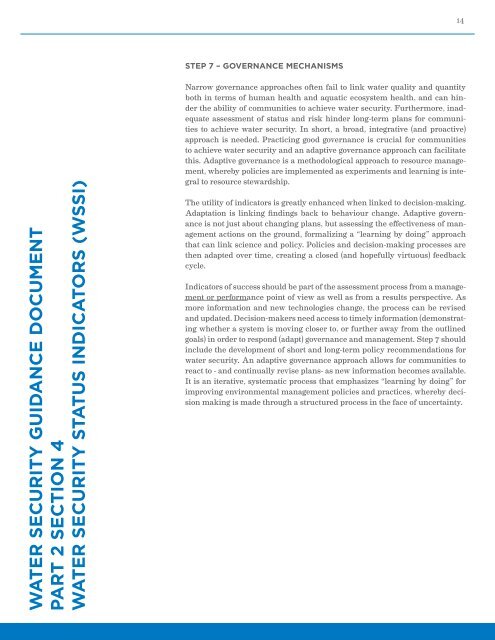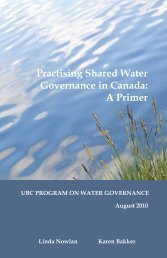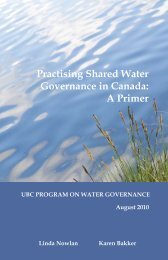Water Security Status Indicators - Program on Water Governance
Water Security Status Indicators - Program on Water Governance
Water Security Status Indicators - Program on Water Governance
Create successful ePaper yourself
Turn your PDF publications into a flip-book with our unique Google optimized e-Paper software.
WATER SECURITY GUIDANCE DOCUMENT<br />
PART 2 SECTION 4<br />
WATER SECURITY STATUS INDICATORS (WSSI)<br />
STEP 7 – GOVERNANCE MEChANISMS<br />
Narrow governance approaches often fail to link water quality and quantity<br />
both in terms of human health and aquatic ecosystem health, and can hinder<br />
the ability of communities to achieve water security. Furthermore, inadequate<br />
assessment of status and risk hinder l<strong>on</strong>g-term plans for communities<br />
to achieve water security. In short, a broad, integrative (and proactive)<br />
approach is needed. Practicing good governance is crucial for communities<br />
to achieve water security and an adaptive governance approach can facilitate<br />
this. Adaptive governance is a methodological approach to resource management,<br />
whereby policies are implemented as experiments and learning is integral<br />
to resource stewardship.<br />
The utility of indicators is greatly enhanced when linked to decisi<strong>on</strong>-making.<br />
Adaptati<strong>on</strong> is linking findings back to behaviour change. Adaptive governance<br />
is not just about changing plans, but assessing the effectiveness of management<br />
acti<strong>on</strong>s <strong>on</strong> the ground, formalizing a “learning by doing” approach<br />
that can link science and policy. Policies and decisi<strong>on</strong>-making processes are<br />
then adapted over time, creating a closed (and hopefully virtuous) feedback<br />
cycle.<br />
<str<strong>on</strong>g>Indicators</str<strong>on</strong>g> of success should be part of the assessment process from a management<br />
or performance point of view as well as from a results perspective. As<br />
more informati<strong>on</strong> and new technologies change, the process can be revised<br />
and updated. Decisi<strong>on</strong>-makers need access to timely informati<strong>on</strong> (dem<strong>on</strong>strating<br />
whether a system is moving closer to, or further away from the outlined<br />
goals) in order to resp<strong>on</strong>d (adapt) governance and management. Step 7 should<br />
include the development of short and l<strong>on</strong>g-term policy recommendati<strong>on</strong>s for<br />
water security. An adaptive governance approach allows for communities to<br />
react to - and c<strong>on</strong>tinually revise plans- as new informati<strong>on</strong> becomes available.<br />
It is an iterative, systematic process that emphasizes “learning by doing” for<br />
improving envir<strong>on</strong>mental management policies and practices, whereby decisi<strong>on</strong><br />
making is made through a structured process in the face of uncertainty.<br />
14







